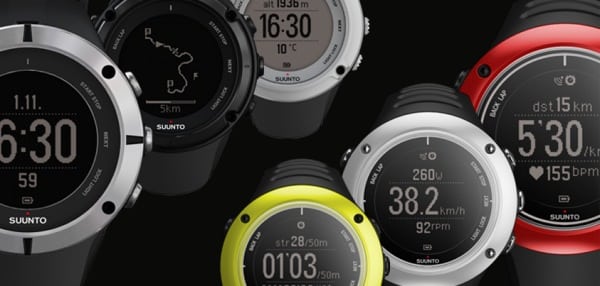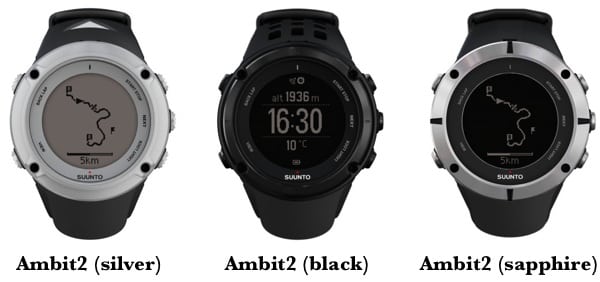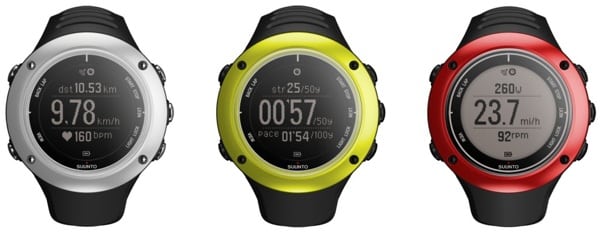Our Favorite GPS Running Watches
For our current favorite GPS watches for running, check out our Best GPS running watch guide.
Suunto Ambit2 and Ambit2 S Preview
A year after its much-anticipated launch, the Suunto Ambit line is being upgraded through bifurcation, specialization, and adaptation to an unexpected level of user engagement. Launching May 1 around the world are the Suunto Ambit2 and Suunto Ambit2 S. The Ambit2 is geared toward the explorer and ultra-distance endurance athlete with the longer battery life of the pair and the inclusion of barometric sensors. On the other hand, the Ambit2 S is slimmed down to provide a lighter, more nimble option for the vast majority of endurance athletes who don’t need crazy-long battery life or barometric altitude sensors. For those happy with the original Suunto Ambit’s feature set, the Ambit will remain in production with the price dropping $100 to $400 with the wrist top unit along and $450 for the Ambit and a heart rate monitor (HRM).
In the following preview, we’ll look at the hallmark features found in the Ambit to Ambit2 upgrade before taking a closer look at each of the devices.

The new Suunto Ambit2 family.
[Editor’s Note: I’ll be updating this preview into a more proper review in the coming days. I’ve been running with the Ambit2 S for the past week, but have not been able to customize the watch interface or play with the data as the update of Suunto’s Movescount platform to Ambit2 compatibility remains imminent.]
Suunto Ambit to Ambit2 Upgrade – It’s “App”ening
Sure, “app” is a buzzword these days, but it can be a very useful one as has been shown to be the case with the Suunto Ambit. Indeed, once users gained the ability to create their own apps and share them on Movescount, there were a flood of new apps. Suunto added some of these functionalities to the original Ambit through software upgrades while users could add other apps of their choice. So successful was the user-based app endeavor that Suunto and users alike bumped into the Ambit’s memory limitations. The desire to allow for future Suunto upgrades and user app-adoption appears to be a or, perhaps, the raison d’être for the new Ambit units.
The Ambit2 and Ambit2 S units themselves will now accept 50 pre-configurable apps whereas the original Ambit could only handle 10 apps with a maximum of one assigned per each sport on the unit. (For those new to the Suunto Ambit, you select which sport you’re about to engage in before you head off.) This means that a trail runner can have up to 50 apps to augment his or her training with the Suunto Ambit2 or Ambit2 S, where as he or she is limited to one app tied to “trail running” running on the original Ambit.
For the multi-sport athlete, apps on the Ambit2 and Ambit 2S can now make use of cycling and swimming data. Perhaps the coolest app or functionality I’ve ever seen on a GPS watch was the cycling drag coefficient app that will be available to Ambit2 and Ambit2 S users.
For the drinkers in the crowd, there’s also a “how much did I drink” app that calculators your blood-alcohol content as it’s ingested and metabolized. If it doesn’t already exist, we can see this being quickly enhanced into a “beer mile” app … although we’d highly suggest that anyone running a beer mile make his or her beer mile “private” in Movescount so as not to … well, let’s just say that’s our suggestion.
Results from two apps per Sport will now be saved following a “move” (i.e., run, ride, or other activity) as opposed to only one app’s data being saved in the past. This data will be accessible via a graph on Movescount.com.
On the programming side, apps can now include rich math and logic functions functions that go beyond the original apps’ limitations of basic math. New variables will also be accessible to the app developer, such as a category of “Tail” variables that refer to the maximum, minimum, and average of that variable over the preceding 30 seconds.
There’s also an advanced code editor for the programmers out there.
Weather data is app accessible on the original Ambit and Ambit2, whereas it’s not accessible on the Ambit2 S, because the Ambit2 S does not record such data.
Suunto Ambit2
Truthfully, I think the Suunto Ambit2 ($500 w/o HRM; $550 w/ HRM) is the new model that’s most likely to appeal to iRunFar’s ultramarathon-leaning audience. Why? Because the Ambit2 maintains the original Ambit’s 15-hour battery life on standard GPS reporting. (Both the Ambit and Ambit2 have up to a 50-hour battery life when recording locations at 60-second intervals, which is bound to underestimate distance anytime you’re on wind-y or switchbacking trails.)
The Ambit2 is actually a hair (or two) heavier than the original Ambit, which weighs in at 78 grams. Strangely, the Ambit2’s weight varies by color with the silver version model weighing 82 grams and the black version weighing 89 grams.
The standout feature of the Ambit2 is its inclusion of both barometric and GPS-based altitude settings, which the unit combines in a FusedAlti measurement that’s sure to stoke the vertical monsters in the crowd.
Like the original Ambit, the Ambit2 retains a barometric pressure reading and graph as well as temperature readings. However, the Ambit2 gives the explorer even more info on his or her surroundings via a series of Suunto apps that provide sunrise/sunset times, tidal info, and a storm warning. Sounds like it’s time explore some fjords!
For the fashionistas among the endurance crowd, there’s the Suunto Ambit2 Sapphire, which has an identical feature set to the standard Ambit2, but with a cosmetically tweaked bezel, sapphire crystal, 3 to 10 extra grams (at 92 grams), and a $100 larger price tag than the standard model ($600 w/o HRM; $650 w/ HRM).
Suunto Ambit2 S
On the hardware side, the Suunto Ambit2 S ($400 w/o HRM; $450 w/ HRM) is primarily an upgrade through subtraction and specialization.
Gone is the original Ambit’s barometric-based altitude measurements in favor of GPS-altitude readings commonly used by most other sports-targeted wrist-top computers. While this may not please the some vert-seekers out there, I think most endurance runners will find this to be an upgrade. Why? Two reasons. First, there’s no need to calibrate the unit’s starting elevation by inputting a known elevation as required by the original Ambit. In theory, this provides more accurate/smoother elevation data; however, it required accurate knowledge of precise elevations and the inputting thereof. Not quite grab and go for folks who start at a variety of trailheads. Second, even if one correctly inputs a correct elevation to calibrate a barometric altimeter, over many hours there can be significant weather-based barometric drift that throws off the accuracy and/or requires intermittent recalibration. Me, I prefer grab and go!
Another subtraction is the halving of the battery capacity on the Ambit2 S versus the identical capacities of the Ambit and Ambit2. With the smaller battery, Suunto rates the Ambit2 S as having 8 hours of battery life on the default one-second GPS recording and 25 hours on the less trail running friendly 60-second mode. The result? A unit that at 72 grams, is 6 grams lighter than the original Ambit. Of perhaps more import, the Ambit2 S is 14% thinner at 15.5 mm versus the Ambit’s and Ambit2’s 18 mm. (Note: The Ambit2 Sapphire is 17.5 mm thick.)
Call for Comments
What are your thoughts on the new Suunto Ambit2 and Ambit2 S?


